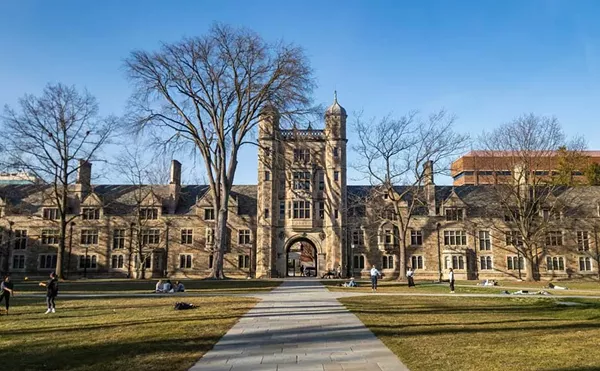Well, I thought about writing how Dick Posthumus, thanks to crass posturing on the water issue, has managed to alienate the one group of voters not deeply in love with Jennifer Granholm. Then I considered explaining how ol’ Jennifer’s concept of “thinking outside the box” means, God help us all, adding a “Homeland Security Corridor” to the “Life Sciences Corridor” by way of building for the economy of the future.
But I just couldn’t do it. Sensibly, I decided to get the hell out of medialand, and fled to Vernor and to a different world, one of neighborhoods and streets which almost never see a minicam or one of Kay Everett’s hats. What you’ll find out there is, in fact, a real community, parts of which look more like Mexico City than Detroit, but where people still know each other and mind what goes on in the barrio.
If you go far enough west, eventually, right across the street from immense Woodmere Cemetery, you’ll see an anomaly in this land of faded brown brick buildings. The Pablo Davis Elder Living Center is one of the nicest, newest senior housing complexes I have ever seen, anywhere. The apartments are clean, comfortable, homey and tidy. The residents, who are black, white and brown, converse in at least two languages.
And as long as we are here, I thought we ought to go meet Pablo Davis himself, who is usually painting in his studio on the second floor.
Someone once asked me, They named it after a living guy? Who isn’t rich? Was he the architect? Well, no, not in the literal sense. Actually, he is a communist — was, in fact, a big “C” Communist for many years.
“Did hard time for it too,” back in the bad old Red Scare days, Pablo says proudly. He’s had four wives, six kids, fought in the Spanish Civil War, knew that other Pablo, Picasso, and had a hell of a rousing old time.
Then, of course, after a lifetime as painter and revolutionary, he decided to grow up and become a community organizer. (He’s just lately been getting the hang of it, but he is only 86.) You see, Pablo, a Jewish guy from Philadelphia who was born Paul Kleinbordt, always has had a soft spot for southwest Detroit.
Today, he lives only a cinder’s throw away from where he first arrived illegally one morning in 1932, a 16-year-old kid who had hopped a freight car to Detroit in search of his hero, Diego Rivera, who had just started the famous murals at the Detroit Institute of Arts. Naturally, the guard at the DIA wouldn’t let him in, but Frida Kahlo, not yet a cult figure on feminist calendars, did. Before long, Rivera was letting the boy help with some of the minor panels, and Pablo, who is known to friends as Steve (don’t ask) had found a career.
Decades later, about 1980, he decided that the party was “intellectually dead and thoroughly corrupt.” So after years of working for a revolution from the top down, he’d put his talents to work on the local level. He helped boost Project SAVE, for Search and Visit the Elderly. “We began to be conscious that there were thousands of old people in the community” who were invisible to all but their immediate caregivers.
He put together an executive board, shamelessly lobbied big business, and got the center built. They couldn’t pay Pablo the salary they promised him, so they named it after him instead, which he says suited him just fine. Meanwhile, he was on to the next project.
“If we are ever to have any hope of becoming a community again, the old have to understand the young, and vice versa,” he says.
SAVE has morphed into Bridging Communities Inc., and what Pablo now wants is a new form of housing that would bring members of various generations together in something he calls the Parkside Intergenerational Center.
Reluctantly, he’s stepping down as executive director. But he’s still heavily involved, and leading the search for a new director who will be paid a real salary. The job merely consists of leading a quiet revolution; bringing a diverse community together, fundraising, raising consciousness and hearts on every side of all the barriers.
Piece of cake. Pablo Davis, by the way, isn’t going off to spend his time watching “American Idol.”
“I’m still painting, still agitating, and I’m not nearly done yet,” he says.
Indeed, he still gives free narrative tours of the famous murals at the DIA, tours in which you might even find out whose idea it was to give one tough-looking auto worker Dick Tracy’s cartoon head.
Any regrets? I asked, watching his brush move in the twilight.
“Hell, no. What I have done is devote my life to art and to revolution, in an attempt to make life better, especially for the working class,” he says, his eyes twinkling under a magnificent white mane of hair.
Haven’t ever seen a story about him in the local papers, have you? Gee, I wonder why.
Dollars for democracy: Brenda Scott’s death last month means that the entire city must have both a primary, likely in February, and then a general election in March to elect one — count ’em, one — new City Council member. This is because Detroit is silly enough to elect all nine council members at large. This will cost, Maryann Mahaffey tells me, about $1.5 million for each round. That‘s money the city won’t have for streetlights or potholes or tearing down crack houses. Naturally, turnout will be microscopic, and the winner will be some familiar recycled name from the crypt, like Benny Napoleon. Voting is important, we all agree. But in this case ... does anyone think there might be a better way?
Jack Lessenberry opines weekly for Metro Times. E-mail [email protected]





